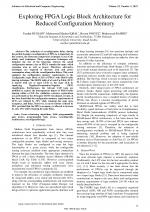| 3/2022 - 2 |
Exploring FPGA Logic Block Architecture for Reduced Configuration MemoryHUSSAIN, F. |
| Extra paper information in |
| Click to see author's profile in |
| Download PDF |
Author keywords
clustering algorithms, field programmable gate arrays, programmable logic arrays, reconfigurable architectures, reconfigurable logic
References keywords
fpga(17), systems(12), logic(12), parvez(10), application(10), specific(8), reconfigurable(8), fpgas(8), computing(8), programmable(7)
Blue keywords are present in both the references section and the paper title.
About this article
Date of Publication: 2022-08-31
Volume 22, Issue 3, Year 2022, On page(s): 15 - 24
ISSN: 1582-7445, e-ISSN: 1844-7600
Digital Object Identifier: 10.4316/AECE.2022.03002
Web of Science Accession Number: 000861021000002
SCOPUS ID: 85137679653
Abstract
The reduction of reconfiguration delay, during the partial dynamic reconfiguration of FPGAs, is important. In this context, the bitstream compression technique is one of the widely used techniques. These compression techniques only minimize the size of the bitstream whereas the actual configuration memory size on FPGA remains the same, which consumes area as well as power. Therefore, alternative techniques are required to decrease area and power consumption along with the reconfiguration delays. This work optimizes the configuration memory requirements in the Configurable Logic Block (CLB) of FPGA with SRAM table sharing technique. The SRAM table of a Look-Up-Table (LUT) is shared with one or more LUTs in the same CLB by employing Negation-Permutation-Negation (NPN) classification. Furthermore, the relevant CAD tools are modified to explore the heterogeneous degree of SRAM table sharing within a CLB. For validation, extensive explorations are performed on the 20 largest MCNC benchmark circuits. It has been found that the configuration memory requirements of LUTs are reduced by 30% while retaining the same area, occupancy, and delay. Moreover, it can be further reduced by 50% provided that the FPGA occupancy is allowed to increase by only 15% while retaining the same delay. |
| References | | | Cited By |
Web of Science® Times Cited: 0
View record in Web of Science® [View]
View Related Records® [View]
Updated 2 days, 20 hours ago
SCOPUS® Times Cited: 1
View record in SCOPUS® [Free preview]
View citations in SCOPUS® [Free preview]
[1] Design and Performance Analysis of Configurable Logic Block (CLB) for FPGA using Various Circuit Topologies, Ramana Kumari, J. L. V., Kranthi Kumar, V., Abhignya, M., Shiva Rama Krishna, P., 2024 3rd International Conference for Innovation in Technology (INOCON), ISBN 979-8-3503-8193-1, 2024.
Digital Object Identifier: 10.1109/INOCON60754.2024.10511683 [CrossRef]
Disclaimer: All information displayed above was retrieved by using remote connections to respective databases. For the best user experience, we update all data by using background processes, and use caches in order to reduce the load on the servers we retrieve the information from. As we have no control on the availability of the database servers and sometimes the Internet connectivity may be affected, we do not guarantee the information is correct or complete. For the most accurate data, please always consult the database sites directly. Some external links require authentication or an institutional subscription.
Web of Science® is a registered trademark of Clarivate Analytics, Scopus® is a registered trademark of Elsevier B.V., other product names, company names, brand names, trademarks and logos are the property of their respective owners.
Faculty of Electrical Engineering and Computer Science
Stefan cel Mare University of Suceava, Romania
All rights reserved: Advances in Electrical and Computer Engineering is a registered trademark of the Stefan cel Mare University of Suceava. No part of this publication may be reproduced, stored in a retrieval system, photocopied, recorded or archived, without the written permission from the Editor. When authors submit their papers for publication, they agree that the copyright for their article be transferred to the Faculty of Electrical Engineering and Computer Science, Stefan cel Mare University of Suceava, Romania, if and only if the articles are accepted for publication. The copyright covers the exclusive rights to reproduce and distribute the article, including reprints and translations.
Permission for other use: The copyright owner's consent does not extend to copying for general distribution, for promotion, for creating new works, or for resale. Specific written permission must be obtained from the Editor for such copying. Direct linking to files hosted on this website is strictly prohibited.
Disclaimer: Whilst every effort is made by the publishers and editorial board to see that no inaccurate or misleading data, opinions or statements appear in this journal, they wish to make it clear that all information and opinions formulated in the articles, as well as linguistic accuracy, are the sole responsibility of the author.



